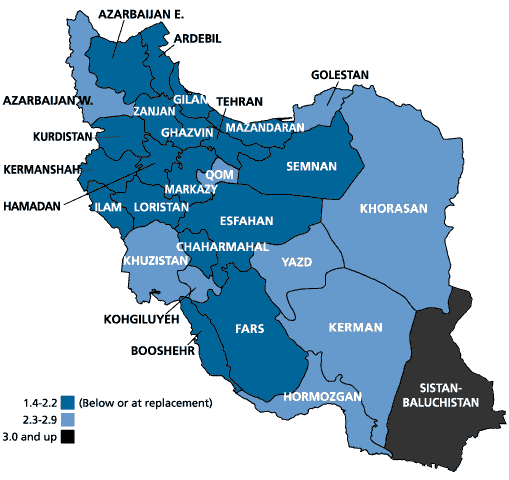
Iran Achieves Replacement-Level Fertility
Date
May 2, 2002
Author
(June 2002) Having dropped from around 5 to just under 3 between 1989 and 1996, Iran’s total fertility rate has again plunged — this time to 2. Iran, an Islamic country, has followed a unique and rapid path to replacement-level fertility. The speedy fertility decline, which has surpassed demographers’ projections, coincided with the revival in late 1989 of government efforts to slow population growth through a national family planning program.
Preliminary results from the 2000 Demographic and Health Survey (DHS) for Iran show a decline of 32 percent in the total fertility rate (TFR, the average number of births per woman) between 1996 and 2000, from nearly 3 to 2. The DHS results are important for at least two reasons. Earlier fertility reductions were documented only by Iranian government surveys and censuses that were not often translated or shared outside the country. The 2000 DHS for the first time provides internationally comparable data, and its huge sample size — which included around 90,000 married women of reproductive age — allows comparison of women’s reproductive behavior by urban and rural areas across all 28 provinces and the Tehran Metropolitan Area.
Changes in Iran’s Total Fertility Rate* and Use of Modern Contraception, by Area
| TFR | ||||||
|---|---|---|---|---|---|---|
| Area | 1977 | 1996 | Preliminary 2000 | % Change, 1977-1996 | % Change, 1996-2000 | % of Married Women Using Modern Contraception, 2000 |
| Urban | 4.5 | 2.2 | 1.8 | 51 | 18 | 55 |
| Rural | 8.1 | 3.5 | 2.4 | 57 | 31 | 57 |
| Total | 6.6 | 2.8 | 2.0 | 58 | 29 | 56 |
*Total fertility rate (TFR) is the average number of children per woman.
Source: Iranian Ministry of Health and Medical Education.
The table above presents changes in TFR for urban and rural areas for selected years between 1977 and 2000. It shows that reduced fertility is not a phenomenon of urban areas alone but is occurring throughout the country. Mohammad Jalal Abbasi-Shavazi, a demographer at the University of Tehran and a presenter at the UN Expert Group Meeting on Completing the Fertility Transition, points to evidence that the rapid decline in births has been the result of simultaneous reduction at all ages: delay in childbearing by young couples, increased spacing of births by married women, and cessation of births by older women.
Such widespread acceptance of the two-child norm is largely due to the national campaign encouraging small families; to the national health care network, which has delivered family planning to all parts of the country and to families from all income levels in the context of primary health care while also reducing infant mortality; to government programs promoting rural development and literacy; and to the country’s Islamic leadership’s support for family planning. (For background on the country’s family planning efforts, see the July/August 1999 issue of Population Today.)
The combination of all these factors, while not altering women’s legal rights, has improved women’s status, according to Farzaneh Roudi, a policy analyst with the Population Reference Bureau. “Many people from outside Iran assume that, because the government obliges women to wear veils, the government also obliges them to use contraception,” she said, “but the reproductive health program is based on freedom of choice.” She noted, though, that “choice” does not, as it does in some other Muslim countries like Turkey and Tunisia, mean access to abortion, which remains illegal in Iran except to save a mother’s life (although abortion is thought to be practiced in some urban areas). With control over their reproduction, Roudi said, women are choosing to have fewer children and to be more in control of their lives. As they spend less time engaged in reproduction and childrearing than they did a generation ago, they have more time to be active in public life — to engage in volunteerism and to participate and vote in national and local elections. In rural and urban Islamic Council elections in 1999, more than 7,250 women were candidates.
Changes in women’s access to reproductive health services and education are reflected in these additional data from DHS and other sources:
- More than 90 percent of pregnant women received at least two prenatal check-ups. Ninety-five percent of births are attended by a doctor or trained midwife.
- Seventy-four percent of married women use a family planning method; 56 percent of married women use a modern method. The gap between rural and urban areas in modern contraceptive use has closed.
- The average age at first marriage has risen since 1980 from around 17 for rural and urban women to 20 for rural and 21 for urban women in 2000.
- From 1996 to 2000, the percentage of never-married women has increased: for 20-to-24-year-olds, from 40 percent to 47 percent; and for 25-to-29-year-olds, from 15 percent to 21 percent.
- In 2000, the majority of candidates accepted at government universities were women. (Still, the percentage of women who are economically active — in the labor force or looking for work — is only around 19 percent for those in urban areas and around 28 percent for those in rural areas, according to the DHS.)
Total Fertility Rate by Province, Iran, 2000

Source: Iranian Ministry of Health and Medical Education, UNICEF, and UNFPA, Demographic and Health Survey Iran 2000, Preliminary Draft Report (2002).
Where does the country go from replacement? Now that small family size and contraceptive use are well-established, the government is debating whether to discontinue subsidizing or at least to decrease investment in family planning efforts; in 2000, 75 percent of family planning services were provided by the Ministry of Health and Medical Education. According to Roudi, the director of the national family planning program plans to focus on regional disparities in contraceptive use (reflected in the map of TFRs above) and on dealing with unplanned pregnancies, which made up about one quarter of pregnancies recorded in the 2000 DHS. Emergency contraceptives are being added to the services provided by the health network.
As for women, Roudi speculated: “Now that Iranian women have achieved greater reproductive rights, they are asking their government for more rights in general.” Abbasi-Shavazi, too, underscores the improvement in some aspects of women’s lives. He cites Jaleh Shadi-Talab, director of the Center for Women’s Studies of the University of Tehran, as saying that improvement in the status of women, which has come about through these development efforts, has itself become an “accelerating force of development in Iran.”
Allison Tarmann is editor of Population Today.
For More Information
For an article detailing the UN Expert Group Meeting on Completing the Fertility Transition see “Fertility Down, but Population Decline Still Not in Sight,” from the May/June 2002 issue of Population Today.
The paper on Iran that Mohammad Jalal Abbasi-Shavazi presented at the UN’s Expert Group Meeting on Completing the Fertility Transition, “Recent Changes and the Future of Fertility in Iran,” is available online at www.un.org/esa/population/publications/completingfertility/ABBASIpaper.PDF.
For background on Iran’s family planning efforts, see “Iran’s Revolutionary Approach to Family Planning,” Population Today, July/August 1999 (PDF: 65KB).






